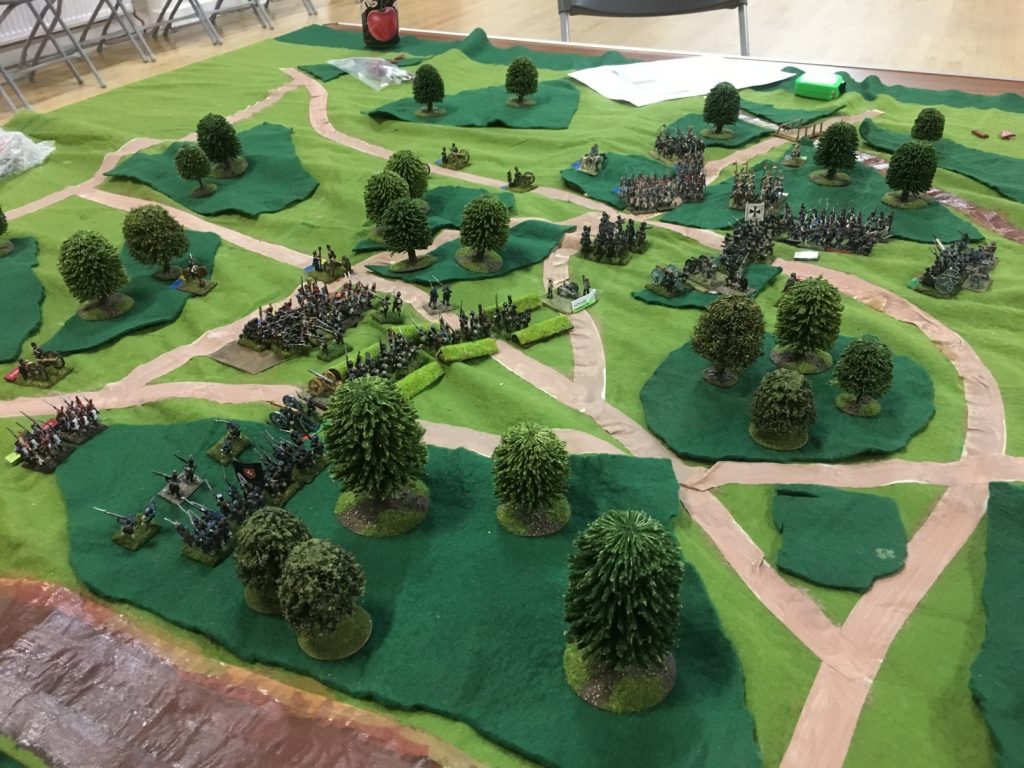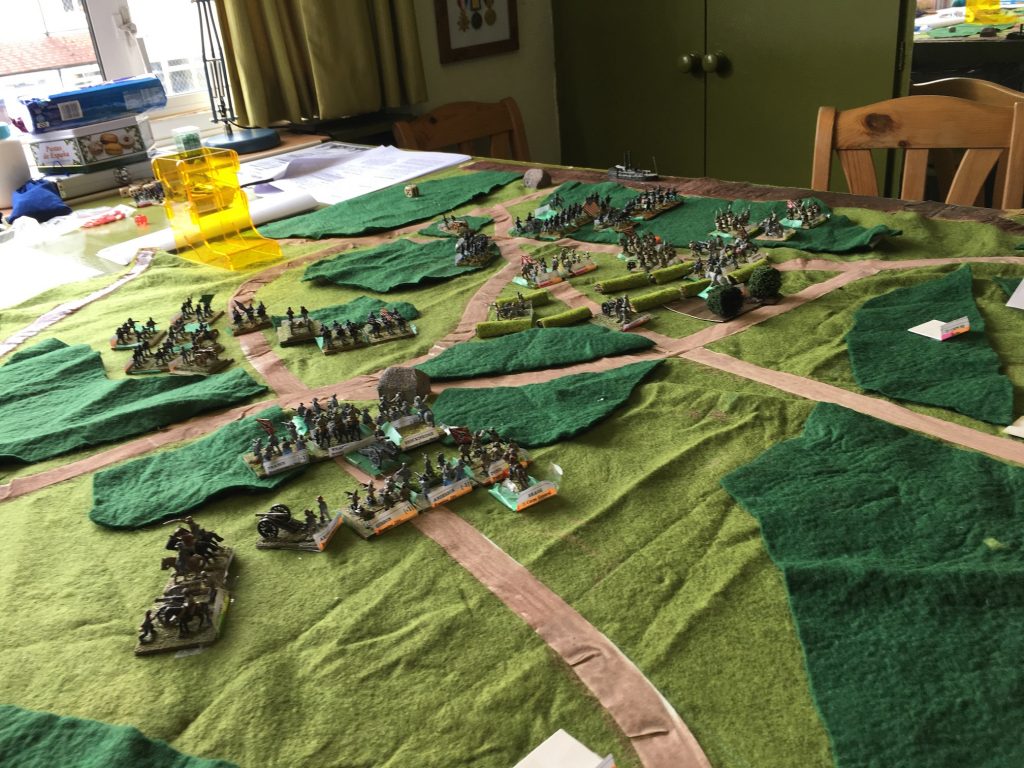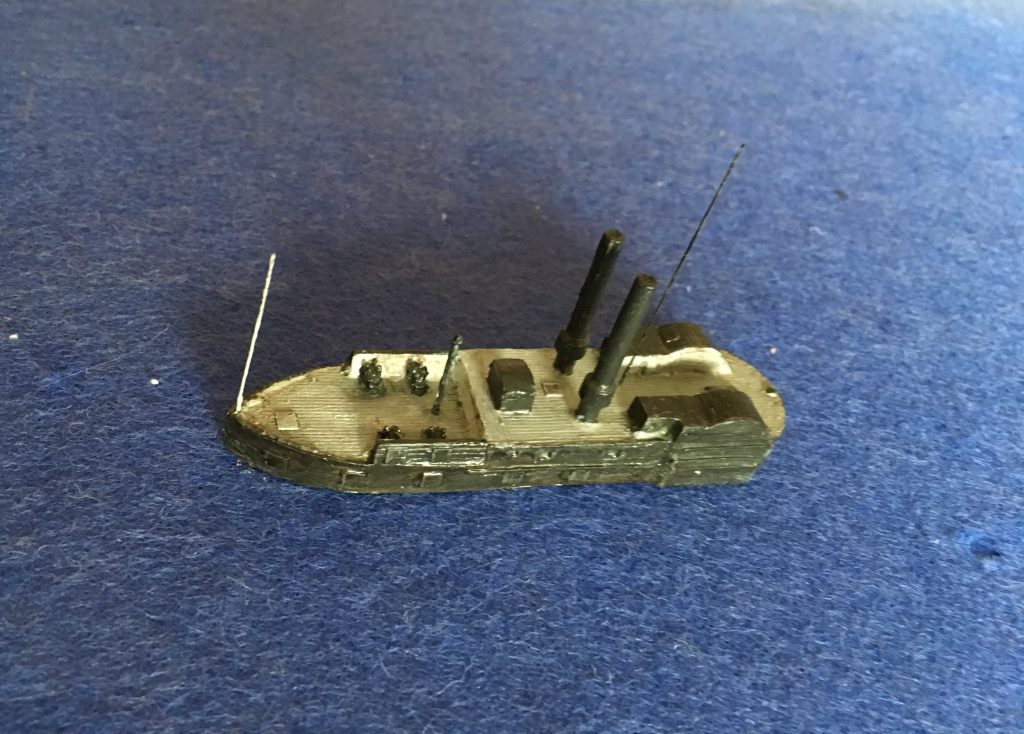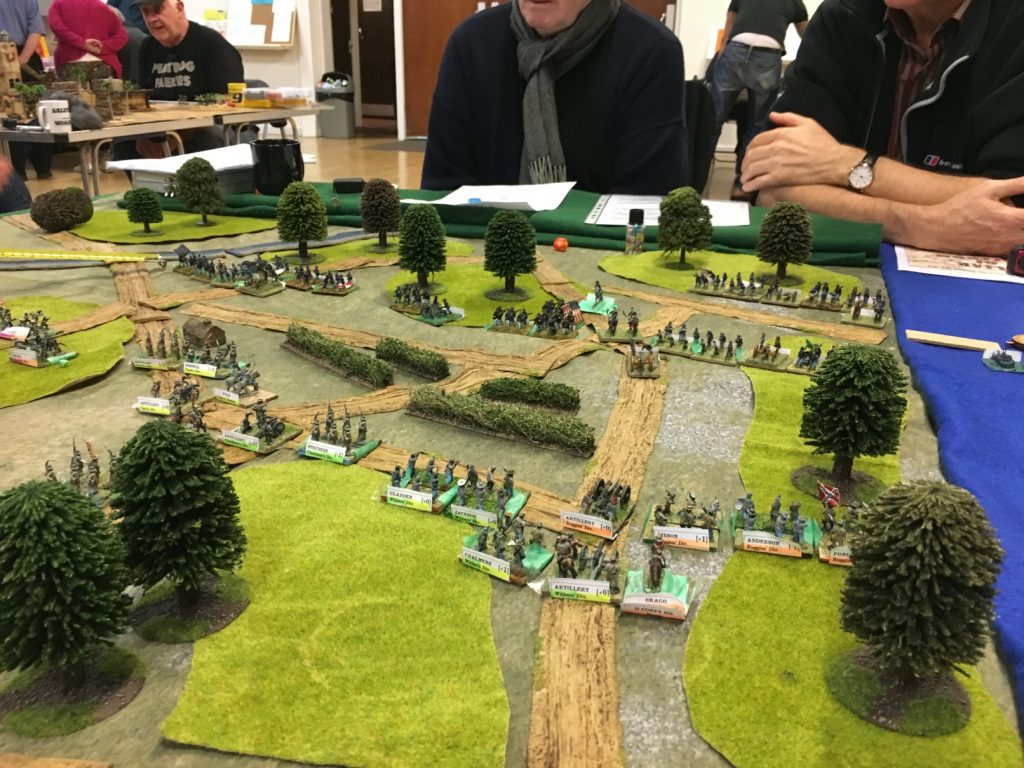
Last night Terry and I used my cloth for the Altar of Freedom game on Shiloh to refight a Napoleonic version using our version of BBB. It was fought using my Napoleonic French and Prussian armies. It is interesting to compare the two systems.
The distance scales are the same, which meant there was not problem in using the same terrain layout. The main difference in game layout is that BBB is played using brigade units (two or three to a division), while BBB has division sized units. Each AoF brigade corresponds to two BBB bases. That means a two brigade division has four bases and a three brigade one six. That makes BBB a bit more compact, but the frontages are broadly similar using the 40mm bases for AoF that we have being doing. Using the recommended 60mm bases would mean that two brigades could cover five inches easily and six at a pinch. A BBB equivalent division would cover four inches. Artillery units are pretty much the same between the two systems. Cavalry is different mainly because of the different cavalry role between the Napoleonic and ACW eras. In BBB we use a much lower figure ratio, since firepower is unimportant. A typical BBB cavalry unit is a brigade, the same as AoF, but it has a bigger footprint.
In putting together the armies I wanted to keep my standardised 1815 units rather than do a new lot of labels. The French took the Confederate role. Bragg’s corps of six brigades translated into three four-base divisions, but otherwise the conversion was quite simple. Command and control was harder. I did not provide leaders for the counterparts of Polk and Breckinridge, but Bragge and Hardee’s counterparts were on the table, as well as Johnstone represented by Napoleon himself. On the Union side all the divisions were three brigades, so it was quite easy to give them Prussian six-base units as equivalents. I divided them into two corps, each with a general, and a commander. I gave the French a slight quality edge: with one Aggressive infantry unit (the Young Guard in the reserve corps) and veteran cavalry. The Prussian had one Raw infantry unit.
We started a bit earlier than a normal club night and got three hours of game time in. In that time we played four and a half moves. That was no quicker than AoF, in spite of the smaller number of playing pieces. But there were only two of us (rather than four) and more did happen. The French (played by Terry) started with an aggressive assault on their left and centre. This went badly, with some effective firing by the Prussians, followed by a good close combat result. In the second move one of the French units was destroyed, and that left three of the smaller French units facing off against two Prussian ones in a static stalemate. I was mulling a counterattack.
But with this failure, the French decided to switch to the left, throwing in their reserve corps against the open Prussian flank. This fared much better, with the Prussians struggling to hold off superior numbers. A spectacular cavalry counterattack managed to do for a second French infantry unit, but the two front line Prussian infantry units were flagging to the point of near collapse, though the lead French infantry was similarly flagging. But they had two fresh infantry units (including the Young Guard), backed by two cavalry units, to face one not so fresh Prussian infantry unit and the triumphant cavalry. Meanwhile the wooded terrain was making the artillery hard to organise. I thought the Prussians were losing at the end (given that we had only reached midday), but it wasn’t hopeless. It was an exciting game.
How did the systems compare? The French/Confederates were able to deliver a much quicker and better coordinated attack in BBB. The Prussians/Union were not able to organise their defence so easily. Vital movement throws failed to come up on several occasions, limiting my ability to pull the defensive line back (something that the Union did very effectively in our AoF games). Not that I can complain too much: I had good combat dice on several critical occasions. The BBB game was much more decisive. By the end of our game the French had lost two infantry divisions and a battery out of action, two spent and another one damaged (one base loss), and one cavalry unit damaged. The Prussians had lost no units, but two infantry units were spent and the other three damaged (they only had five, until the possibility of reinforcements much later). At the equivalent stage in our AoF games at most one brigade had been put out of action.
This reflects each system’s strengths and weaknesses. In AoF command and control limitations were much greater on the Confederate side, making their attack much slower to progress, and limiting them to two or three divisions a turn. The Union side had much more flexibility. But BBB combat handles attrition much better. A lot of this is due to my modified rules for Napoleonics. Core BBB would have meant many fewer losses. This may be a fair reflection of the difference between the two eras, before the needle gun and chassepot suddenly upped the casualties.
Another difference is that artillery movement is much more flexible in AoF. In BBB you cannot limber and unlimber in the same turn, which makes it harder to move artillery around. We have made it more flexible in our version than core BBB (so that you can limber/unlimber and move a full move), but it is still hard, as I found as the Prussian line faltered. If the infantry gave ground it effectively meant the accompanying artillery couldn’t operate; it was similarly hard for artillery support to keep up with the attack without pausing it. The artillery needed to fall back further to occupy a new defensive line behind the infantry. This is something I should have been thinking about as the Prussian player. It is exactly how the French approached their withdrawal at Vitoria in 1813, so I don’t think BBB is unrealistic.
Overall I’m quite pleased with our house BBB system. It is working much as intended, and produced an exciting game. The skirmisher system remains scrappy and needs some cleaning up. The cavalry flowed through the woods and conducted attacks there a bit too easily. I am planning a substantial revision which will also address the disruption issue: inflicting disruption on a unit that is already disrupted doesn’t affect it. But I’m also working on something much more original that deals with some of BBB’s deeper problems. Meanwhile I think AoF works perfectly well for ACW, and represents command and control issues much better.
One more learning is on terrain. I have constructed a terrain cloth for Shiloh, with painted masking tape for roads and revers, and patches of felt taped on for woods. It can be folded up and is very portable, while representing complex terrain much better than using just standard club equipment. Last night we put the cloth on top of another felt cloth – this didn’t work well and led to it rumpling easily. Felt needs to be placed on a frictionless surface to lie flat. I think the idea can be developed – though hills are an unsolved issue and the rivers don’t work as well as the roads.



